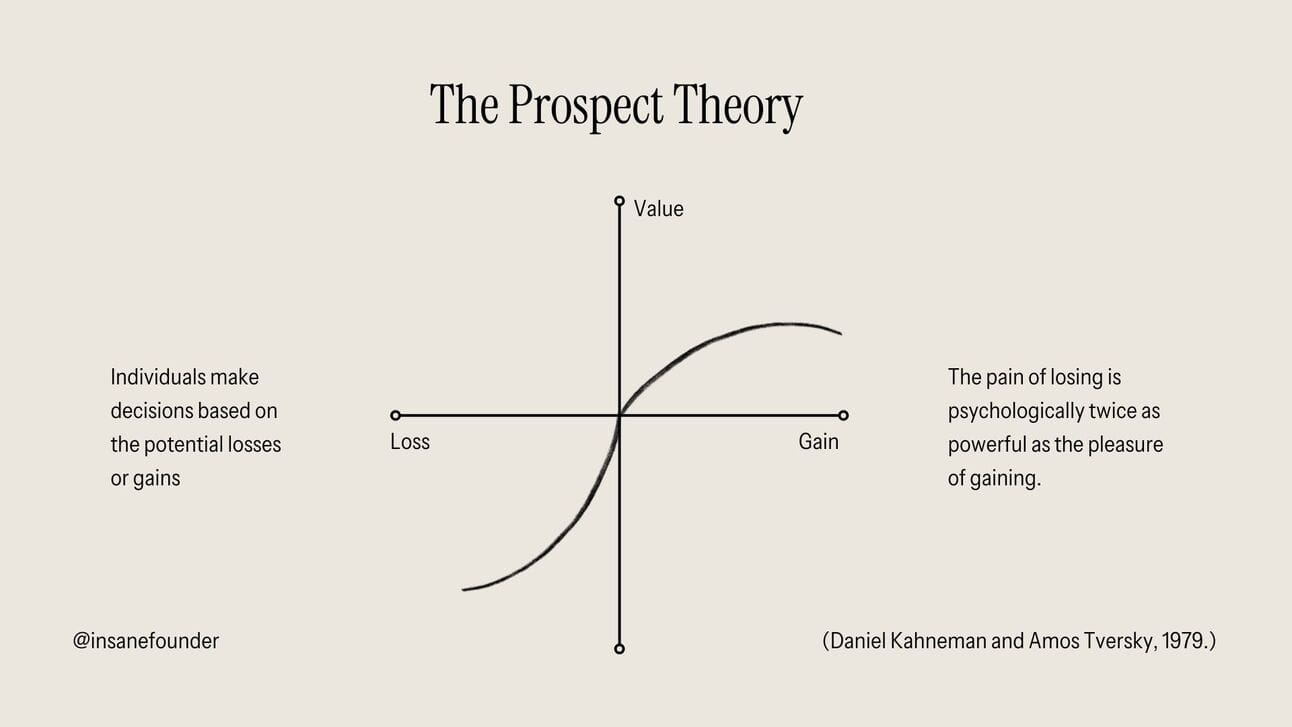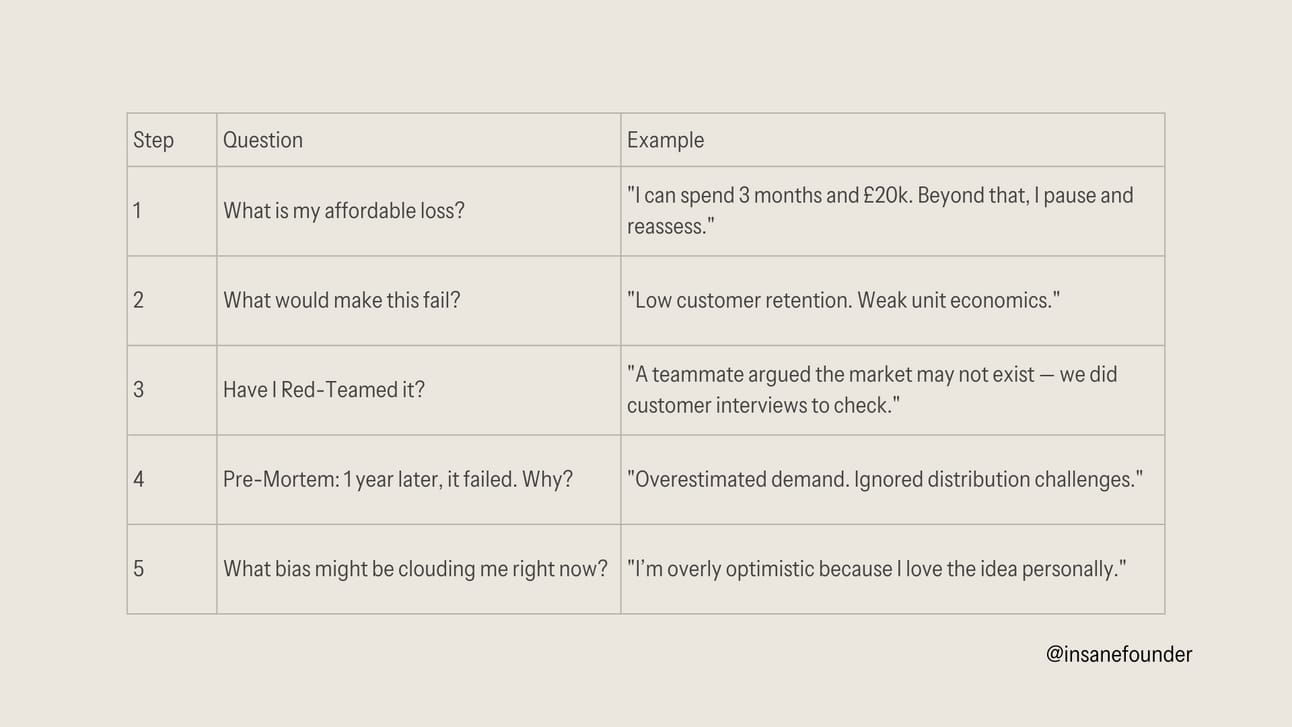Hello founders,
Tomorrow, I’m stepping into the unknown with a completely new project we’ve been building. As excited as I am to finally kick it off, I’m also noticing fear and doubt creeping into my mind.
Moments like this remind me: the best thing I can do is let go of the noise and throw myself fully into action. Overthinking rarely serves us. Progress only comes from enough failed attempts stacked on top of each other.
Stepping into the unknown tends to be the ‘comfort zone’ for any founder. With each trial and error, over time, we come to understand our personal risk appetite, not by thinking about it, but by living through it.
Today, we dive into the science behind founders’ risk appetite, the decision biases that creep in, and how to sharpen your instincts without losing your edge, so you can better strategise your next big move.
The average person makes 35,000 decisions each day. Cognitive biases are quietly steering our decisions, especially under pressure. Some biases are almost like superpowers for founders, fuelling persistence. Others can lead them straight into preventable mistakes.
Here are a few key biases that lead to mental traps for founders:
Optimism Bias
"It’ll work out, because it has to!" This bias makes you believe success is more likely than it objectively is. You might underestimate obstacles, overestimate customer enthusiasm, or assume competitors will stay slow and clumsy.
Overconfidence Bias
It’s that feeling that you know better than the market, that your intuition is bulletproof. Research shows entrepreneurs consistently overestimate their ability to predict outcomes and control external forces.
Sunk Cost Fallacy
We typically see this in early-stage teams, without much feedback from users, they tend to keep shipping more features, hoping it will make the product more desirable. But this is where the sunk cost fallacy kicks in: when something isn’t working, they double down, pouring more time, energy, and resources into a flawed direction. The founder of Deel, the fastest-growing SaaS in history, mentioned his experience in this interview.
Action Bias
Founders love to move fast. But sometimes the need to do something leads to hasty decisions that cause bigger problems later. Pausing, reflecting, or simply waiting can feel uncomfortable, even when it’s strategically smarter.

The prospect theory. Daniel Kahneman and Amos Tversky, 1979
Daniel Kahneman and Amos Tversky’s Prospect Theory (1979) showed that people value potential losses much more heavily than potential gains. Yet entrepreneurs often flip this script: their optimism and overconfidence dampen fear of loss, making risky bets feel less daunting.
Modern neuroeconomic studies add even more depth: brain imaging tells us that high-risk decisions activate the amygdala (fear center) and reward systems simultaneously, creating a tug-of-war between hope and panic (Knutson and Bossaerts, 2007). Founders, living perpetually on this edge, often develop coping mechanisms that both empower and betray them.
Founders often frame risks differently - where others might see a chasm, we often see a bridge — or at least a thrilling leap worth taking.
The way risk is framed changes everything. If a decision is framed around "potential loss," it feels dangerous. But if it’s framed around "potential gain," it feels exciting. Entrepreneurs tend to lean into the gain mindset, seeing uncertainty as a playground rather than a battlefield.
Practical takeaway: Saras Sarasvathy’s Effectuation Theory (2001) captures this beautifully. Her research showed that successful entrepreneurs rarely think in terms of expected return on investment. Instead of obsessing over the odds of success, they develop an "affordable loss" mindset, and ask:
“What can I afford to lose?”
This means they don’t bet the farm on a single idea. They make many small, controlled bets, adjusting course as reality unfolds. Thinking this way doesn’t just protect you — it frees you to move faster and take smart risks without paralyzing fear.
How to Harness Risk Intelligently
You can't eliminate cognitive biases. They're part of being human. But you can recognize them and build systems that keep them in check — without losing your daring spirit.
Here’s how to channel your inner daredevil without losing your shirt:
Build "red teams"
Before launching an idea, play devil’s advocate. Gather trusted people to intentionally poke holes in your plans. Assume you're wrong and try to prove it. It’s uncomfortable — and invaluable.
Fall in love with pre-mortems
Instead of waiting for something to fail and doing a post-mortem, run a pre-mortem. Imagine it's one year from now and your project has failed spectacularly. Why? Mapping out failure scenarios ahead of time uncovers blind spots you’d otherwise miss.
Set affordable loss thresholds
For risky moves, decide upfront what you’re willing to lose — time, money, energy — and stick to it. This keeps decisions grounded and emotions in check.

Most importantly, remember: Courage isn’t the absence of fear. It’s deciding something is worth trying even if it fails.
Understanding your own psychology isn’t just a "nice to have" — it’s a competitive advantage.
The sharper you get at seeing your biases and reframing your risks, the more resilient (and happier) you’ll be as a founder.
Your turn:
What’s the biggest risk you’ve taken lately — or a decision trap you caught yourself in? I'd love to hear.

